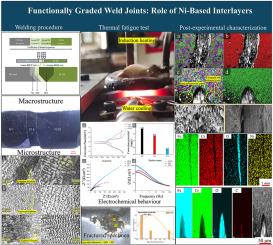Influence of nickel-based interlayers on mechanical, corrosion, and thermal fatigue performance of functionally graded weld joints between P91 steel and SS304
IF 4.7
3区 材料科学
Q2 MATERIALS SCIENCE, MULTIDISCIPLINARY
引用次数: 0
Abstract
This study introduces a novel methodology for fabricating functionally graded weld joints (FGWJ). This method employs the activated gas tungsten arc welding process (A-TIG), incorporating nickel-based interlayers. This study aims to enhance the weld joints' mechanical integrity, corrosion resistance, and thermal stability. FGWJs address key challenges like uneven thermal expansion, accelerated degradation at high temperatures, and high corrosion rate at the weld joint between P91 and SS304. The distinct transition zones of FGWJ ensure smooth property gradation, enhancing toughness, thermal fatigue life and electrochemical stability. The dilution of nickel-based interlayers yielded a predominantly austenitic microstructure across all three fusion zones, with trace amounts of δ-ferrite confined to FZ II. This led to a gradual increase in both impact toughness (FZ I: 40.5 J, FZ II: 46 J, FZ III: 59 J) and corrosion resistance (FZ I: 0.75 mpy, FZ II: 0.55 mpy, FZ III: 0.15 mpy), without compromising tensile strength (550 MPa, 84.6 % joint efficiency, 35 % elongation). Furthermore, this microstructural transformation achieved a 110 % improvement in thermal fatigue life compared to the direct joining of a conventional P91–SS304 weld without any filler metal. Ni-based interlayers in FGWJs improve the mechanical properties, thermal fatigue life and corrosion resistance of dissimilar steel welds for power generation and chemical industry applications.

镍基夹层对P91钢与SS304功能梯度焊接接头力学、腐蚀和热疲劳性能的影响
本研究介绍了一种制造功能梯度焊接接头(FGWJ)的新方法。该方法采用活性气体钨极电弧焊工艺(A-TIG),结合镍基中间层。本研究旨在提高焊接接头的机械完整性、耐腐蚀性和热稳定性。fgwj解决了P91与SS304之间的热膨胀不均匀、高温下加速降解以及焊缝腐蚀速率高等关键问题。不同的过渡区确保了FGWJ的平滑性能分级,提高了韧性、热疲劳寿命和电化学稳定性。镍基中间层的稀释在所有三个熔合区产生了主要的奥氏体微观结构,微量的δ-铁素体局限于FZ II。这导致冲击韧性(FZ I: 40.5 J, FZ II: 46 J, FZ III: 59 J)和耐腐蚀性(FZ I: 0.75 mpy, FZ II: 0.55 mpy, FZ III: 0.15 mpy)逐渐增加,而不影响抗拉强度(550 MPa, 84.6%接头效率,35%伸长率)。此外,与不使用任何填充金属的传统P91-SS304焊缝直接连接相比,这种显微组织的转变使热疲劳寿命提高了110%。ni基夹层可改善发电和化工领域异种钢焊缝的力学性能、热疲劳寿命和耐腐蚀性。
本文章由计算机程序翻译,如有差异,请以英文原文为准。
求助全文
约1分钟内获得全文
求助全文
来源期刊

Materials Chemistry and Physics
工程技术-材料科学:综合
CiteScore
8.70
自引率
4.30%
发文量
1515
审稿时长
69 days
期刊介绍:
Materials Chemistry and Physics is devoted to short communications, full-length research papers and feature articles on interrelationships among structure, properties, processing and performance of materials. The Editors welcome manuscripts on thin films, surface and interface science, materials degradation and reliability, metallurgy, semiconductors and optoelectronic materials, fine ceramics, magnetics, superconductors, specialty polymers, nano-materials and composite materials.
 求助内容:
求助内容: 应助结果提醒方式:
应助结果提醒方式:


